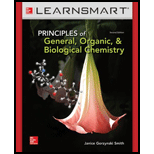
Concept explainers
a.
Interpretation:
Stage of catabolism in that cleavage of protein with chymotrypsin has to be determined.
Concept Introduction:
Catabolic pathways are organized in four stages as follows:
Digestion is the first stage for energy production. In this stage, food molecules like carbohydrates, proteins, and triacylglycerols break down into smaller units by hydrolysis. These units are utilized in further stages of energy and also consumed by body in
Acetyl CoA formation is the second stage for energy production. In this stage, monosaccharides, amino acids, and fatty acids are reduced to form two-carbon units. This two carbon unit is bonded to coenzyme A to form acetyl CoA.
Citric acid cycle is the third stage for energy production. In this stage, acetyl CoA is oxidized to form
Electron transport chain and oxidative phosphorylation is the fourth stage for energy production. In this stage,
a.
Explanation of Solution
Chymotrypsin is enzyme that known to break protein into individual amino acids. It is used in small intestine. It functions to target only
Since chymotrypsin breaks long protein into smaller amino acid molecules thus it occurs in stage (1).
b.
Interpretation:
Stage of catabolism in that oxidation of fatty acid to acetyl CoA has to be determined.
Concept Introduction:
Refer to part a.
b.
Explanation of Solution
Long fatty acid reduced to two-carbon unit that is acetyl CoA in stage (2) of catabolism. This stage converts monosaccharides, amino acids, and fatty acids into acetyl CoA.
c.
Interpretation:
Stage of catabolism in that oxidation of malate to oxaloacetate with
Concept Introduction:
Refer to part a.
c.
Explanation of Solution
Conversion of malate to oxaloacetate is taken place in citric acid cycle. Citric acid cycle is part of stage (3) of catabolism. Thus oxidation of malate to oxaloacetate with
d.
Interpretation:
Stage of catabolism in that conversion of ADP to ATP with ATP synthase has to be determined.
Concept Introduction:
Refer to part a.
d.
Explanation of Solution
Conversion of ADP to ATP with ATP synthase is taken place in electron transport chain. In electron transport chain,
e.
Interpretation:
Stage of catabolism in that hydrolysis of starch to glucose with amylase has to be determined.
Concept Introduction:
Refer to part a.
e.
Explanation of Solution
Conversion of starch to glucose with amylase is a conversion of polysaccharides to small unit of monosaccharides. Since large molecule broken into small molecule comes under stage (1) of catabolism thus hydrolysis of starch to glucose with amylase occurs in stage (1) of catabolism.
Want to see more full solutions like this?
Chapter 18 Solutions
Connect Access Card for Principles of General, Organic & Biochemistry
 Introduction to General, Organic and BiochemistryChemistryISBN:9781285869759Author:Frederick A. Bettelheim, William H. Brown, Mary K. Campbell, Shawn O. Farrell, Omar TorresPublisher:Cengage Learning
Introduction to General, Organic and BiochemistryChemistryISBN:9781285869759Author:Frederick A. Bettelheim, William H. Brown, Mary K. Campbell, Shawn O. Farrell, Omar TorresPublisher:Cengage Learning
 Chemistry for Today: General, Organic, and Bioche...ChemistryISBN:9781305960060Author:Spencer L. Seager, Michael R. Slabaugh, Maren S. HansenPublisher:Cengage Learning
Chemistry for Today: General, Organic, and Bioche...ChemistryISBN:9781305960060Author:Spencer L. Seager, Michael R. Slabaugh, Maren S. HansenPublisher:Cengage Learning General, Organic, and Biological ChemistryChemistryISBN:9781285853918Author:H. Stephen StokerPublisher:Cengage Learning
General, Organic, and Biological ChemistryChemistryISBN:9781285853918Author:H. Stephen StokerPublisher:Cengage Learning Organic And Biological ChemistryChemistryISBN:9781305081079Author:STOKER, H. Stephen (howard Stephen)Publisher:Cengage Learning,
Organic And Biological ChemistryChemistryISBN:9781305081079Author:STOKER, H. Stephen (howard Stephen)Publisher:Cengage Learning,




